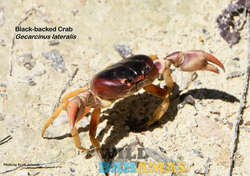
Crazy about Crustaceans!
The phylum Arthropoda encompasses a diverse range of organisms, including insects, centipedes, and millipedes. Among these, crustaceans represent a distinct and highly specialized group. Commonly recognized as crabs, lobsters, shrimp, and crayfish, crustaceans are widely consumed around the world. Yet, they are far more than a culinary interest. Crustaceans inhabit virtually all marine, freshwater, and some terrestrial ecosystems across every continent except Antarctica. While the majority are aquatic, certain


Ecologically, crustaceans fulfill a variety of roles as predators, scavengers, detritivores, and parasites. In The Bahamas, terrestrial crustaceans include the White Land Crab, Black Land Crab, Black-backed Crab, Soldier Crab (Land Hermit Crab), Fiddler Crab, and Woodlouse.
Black Land Crab
Woodlouse, a terrestrial crustacean
lineages have successfully adapted to life on land. Current estimates place the number of known crustacean species between 42,000 and 67,000. If we include insects, which along with crustaceans form the clade Pancrustacea, then we increase the numbers of species to over 1.2 million described species.


fact sheets

COMING SOON!

COMING SOON!

COMING SOON!

COMING SOON!


posters

The Bahamas is home to several species of land crabs, with the largest being the White land crab (Cardisoma guanhumi), while the Black crab (Gecarcinus ruricola) is the most terrestrial, often found far inland in forests and scrublands. Unlike the White crab, the Black crab is not as dependent on water. Caribbean Hermit crabs, also known as Soldier crabs, are unique in that they use external shells for protection. Land crabs are opportunistic omnivores, feeding on various materials like carrion, fruits, and flowers, and they play a vital role as ecosystem engineers by aerating soil and contributing nutrients through their burrows and faeces, which influence plant communities. Land crabs also hold economic importance, particularly as a fishery resource for Bahamians, with the crab harvest contributing significantly to the local economy. Andros Island is home to the largest population of White crabs, thanks to its extensive freshwater and wetlands, but overharvesting is leading to a decline in adult populations. Additionally, climate change poses a growing threat to land crabs, with predictions of decreasing rainfall in the Caribbean, which could exacerbate the effects of overharvesting and further challenge the sustainability of crab populations.

COMING SOON!

COMING SOON!

COMING SOON!


photo gallery
 |  |  |
|---|---|---|
 |  |  |
 |  |


resources
Bernot, J.P., Owen, C.L., Wolfe, J.M., Meland, K., Olesen, J. and Crandall, K.A., 2023. Major revisions in pancrustacean phylogeny and evidence of sensitivity to taxon sampling. Molecular Biology and Evolution, 40(8), p.msad175.
Boxshall, G.A. and Defaye, D., 2008. Global diversity of copepods (Crustacea: Copepoda) in freshwater. Freshwater animal diversity assessment, pp.195-207.
Subphylum Crustacea. http://www.nhc.ed.ac.uk/index.php?page=24.25.312.330.363
VanHook, A.M. and Patel, N.H., 2008. Crustaceans. Current Biology, 18(13), pp.R547-R550.
Yeo, D.C., Ng, P.K., Cumberlidge, N., Magalhaes, C., Daniels, S.R. and Campos, M.R., 2008. Global diversity of crabs (Crustacea: Decapoda: Brachyura) in freshwater. Freshwater animal diversity assessment, pp.275-286.





